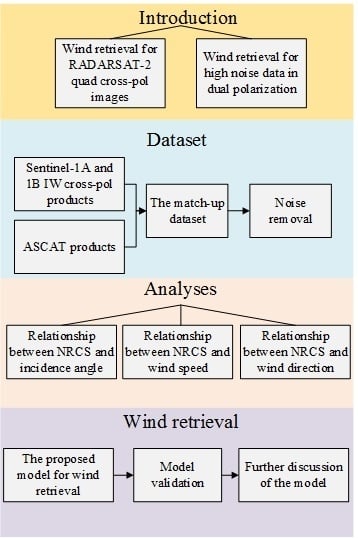Technical Evaluation of Sentinel-1 IW Mode Cross-Pol Radar Backscattering from the Ocean Surface in Moderate Wind Condition
Abstract
:1. Introduction
2. The Matchup Dataset
2.1. Data Collection
2.1.1. Sentinel-1A and 1B
2.1.2. ASCAT
2.2. Construction of the Dataset
- Sentinel-1 data preprocessing.
- ASCAT data preprocessing.The ASCAT-L2-coastal products [27] are downloaded. The products are in the NetCDF format. The information of wind vector, geographical position, and acquisition time is extracted by MATLAB programming.
- Integration of the Sentinel-1 and the ASCAT-L2-coastal products.For each SAR image, determine whether the corresponding ASCAT-L2-coastal product is acquired at the same zone within 2 h window whose center is the SAR acquisition time. If yes, the latitude and longitude coordinates of all the Sentinel-ASCAT match-up points are recorded.
- Selection of the matchup points with precipitation.According to the SAR acquisition time, the corresponding TRMM-3B42 product within 3 h temporal difference is downloaded [29]. Because of the global (lat./lon) -averaged of TRMM-3B42 product [30], all the Sentinel-ASCAT matchup points are integrated with precipitation information. In order to avoid the effect of rainfall on the NRCS , only the matchup points are selected in the dataset and utilized in further analyses.
- Post-processing.The SAR data integrated with wind information are generated. Besides, a XML file is generated for the convenience of retrieving the integrated information of each matchup data.
2.3. Noise Removal
- Based on the calculated NESZ measures, data do not satisfy Equation (1) are removed.where denotes the NRCS in , and is the measured NESZ in . Empirical threshold is set to to guarantee the noise free signal is above , which is applicable for cross-pol wind analyses illustrated in [17]. Please note that, we do not apply higher cut-off level since we aimed at finding the minimum cross-pol NRCS for wind retrieval. Thus, some relatively low SNR data are reserved for further analyses.
- NRCS is composed of signal and noise which is particularly high for low SNR cross-pol observations. We attempt to subtract the noise component based on the calculated NESZ measures according to Equations (2)–(5) [15].where , , and denote the NRCS, the NESZ measures, and the noise free signal NRCS in linear scale. denotes the noise free signal NRCS in .
2.4. Experimental Data
3. Experiments and Analyses
3.1. Relationship between NRCS and Incidence Angles
3.2. Relationship between NRCS and Wind Speeds
3.2.1. IW1-Band
3.2.2. IW2-Band
3.2.3. IW3-Band
3.3. Relationship between NRCS and Wind Directions
3.4. Summary
- For Sentinel-1 cross-pol images, the radar backscattering NRCS are fluctuated and negatively correlated with the incidence angles.
- For Sentinel-1 cross-pol images, the values of NRCS reach local maxima at the up- and downwind directions (, and ) and local minima at the crosswind directions ( and ). In addition, the average variation between the NRCS at the up-/downwind directions and the crosswind is about in our experiment.
- Due to the unique TOPSAR technique for the IW mode (three sub-swaths IW1, IW2, IW3), the relationship between the NRCS and wind speeds for three sub-swaths are different and should be analyzed respectively.
- For IW1-band, the relationship between the NRCS and wind speeds is monotonically linear increase, and the slope increases with higher wind speeds. The data can be divided into three groups. When the wind speed is lower than , the NRCS are scattered with large variation because the radar returns are low. When the wind speed is between and , the variation of the NRCS decreases obviously. This indicates the radar backscattering is sensitive enough to reflect ocean clutter signatures, and thus the wind speed retrieval from cross-pol observations is valid. When the wind speed is above , the wind speed sensitivity, as reflected in slope, increases with higher wind speeds, suggesting the potential of Sentinel-1 cross-pol to high wind retrievals.
- For the IW2-band, the relationship between the NRCS and wind speeds is monotonically linear increase. When the wind speed is lower than , the NRCS are scattered with large variation because the radar return signals are low. When the wind speed is higher than , the variation of the NRCS decreases obviously. The radar backscattering is sensitive enough to reflect ocean clutter signatures, and thus the wind speed retrieval from cross-pol observations is valid.
- For the IW3-band, due to the higher incidence angles, we infer that for IW3-band, the NRCS can not reflect the radar backscattering of ocean clutter signatures, and the accuracy of wind retrieval can not be guaranteed in moderate wind condition (<20).
4. Proposed Model for Sentinel-1 Cross-Pol Wind Retrieval
4.1. Wind Speed Function
4.2. Wind Direction Compensation
4.3. Incidence Angle Function
4.4. Model Validation
5. Discussion
5.1. Influence of Different Samples of Training and Testing Sets
5.2. Influence of Different Number of Pixels for SAR Chip
6. Conclusions
Acknowledgments
Author Contributions
Conflicts of Interest
References
- Hersbach, H. CMOD5: An Improved Geophysical Model Function for ERS C-Band Scatterometry; European Centre for Medium-Range Weather Forecasts: Reading, UK, 2003. [Google Scholar]
- Xu, Q.; Lin, H.; Li, X.; Zuo, J.; Zheng, Q.; Pichel, W.G.; Liu, Y. Assessment of an analytical model for sea surface wind speed retrieval from spaceborne SAR. Int. J. Remote Sens. 2010, 31, 993–1008. [Google Scholar] [CrossRef]
- Wackerman, C.C.; Clemente-Colón, P.; Pichel, W.G.; Li, X. A two-scale model to predict C-band VV and HH normalized radar cross section values over the ocean. Can. J. Remote Sens. 2002, 28, 367–384. [Google Scholar] [CrossRef]
- Yang, X.; Li, X.; Pichel, W.G.; Li, Z. Comparison of ocean surface winds from ENVISAT ASAR, MetOp ASCAT scatterometer, buoy measurements, and NOGAPS model. IEEE Trans. Geosci. Remote Sens. 2011, 49, 4743–4750. [Google Scholar] [CrossRef]
- Yang, X.; Li, X.; Zheng, Q.; Gu, X.; Pichel, W.G.; Li, Z. Comparison of ocean-surface winds retrieved from QuikSCAT scatterometer and Radarsat-1 SAR in offshore waters of the US west coast. IEEE Geosci. Remote Sens. Lett. 2011, 8, 163–167. [Google Scholar] [CrossRef]
- Liu, G.; Yang, X.; Li, X.; Zhang, B.; Pichel, W.; Li, Z.; Zhou, X. A systematic comparison of the effect of polarization ratio models on sea surface wind retrieval from C-band synthetic aperture radar. IEEE J. Sel. Top. Appl. Earth Obs. Remote Sens. 2013, 6, 1100–1108. [Google Scholar] [CrossRef]
- Hwang, P.A.; Zhang, B.; Toporkov, J.V.; Perrie, W. Comparison of composite Bragg theory and quad-polarization radar backscatter from RADARSAT-2: With applications to wave breaking and high wind retrieval. J. Geophys. Res. Oceans 2010, 115. [Google Scholar] [CrossRef]
- Zhang, B.; Perrie, W.; Vachon, P.W.; Li, X.; Pichel, W.G.; Guo, J.; He, Y. Ocean vector winds retrieval from C-band fully polarimetric SAR measurements. IEEE Trans. Geosci. Remote Sens. 2012, 50, 4252–4261. [Google Scholar] [CrossRef]
- Zhang, B.; Li, X.; Perrie, W.; He, Y. Synergistic measurements of ocean winds and waves from SAR. J. Geophys. Res. Oceans 2015, 120, 6164–6184. [Google Scholar] [CrossRef]
- Kim, T.S.; Park, K.A.; Li, X.; Mouche, A.A.; Chapron, B.; Lee, M. Observation of Wind Direction Change on the Sea Surface Temperature Front Using High-Resolution Full Polarimetric SAR Data. IEEE J. Sel. Top. Appl. Earth Obs. Remote Sens. 2017, 10, 2599–2607. [Google Scholar] [CrossRef]
- Zhang, G.; Li, X.; Perrie, W.; Hwang, P.A.; Zhang, B.; Yang, X. A Hurricane Wind Speed Retrieval Model for C-Band RADARSAT-2 Cross-Polarization ScanSAR Images. IEEE Trans. Geosci. Remote Sens. 2017, 55, 4766–4774. [Google Scholar] [CrossRef]
- Vachon, P.W.; Wolfe, J. C-band cross-polarization wind speed retrieval. IEEE Geosci. Remote Sens. Lett. 2011, 8, 456–459. [Google Scholar] [CrossRef]
- Bergeron, T.; Bernier, M.; Chokmani, K.; Lessard-Fontaine, A.; Lafrance, G.; Beaucage, P. Wind speed estimation using polarimetric RADARSAT-2 images: Finding the best polarization and polarization ratio. IEEE J. Sel. Top. Appl. Earth Obs. Remote Sens. 2011, 4, 896–904. [Google Scholar] [CrossRef]
- Hwang, P.A.; Perrie, W.; Zhang, B. Cross-polarization radar backscattering from the ocean surface and its dependence on wind velocity. IEEE Geosci. Remote Sens. Lett. 2014, 11, 2188–2192. [Google Scholar] [CrossRef]
- Shen, H.; Perrie, W.; He, Y.; Liu, G. Wind speed retrieval from VH dual-polarization RADARSAT-2 SAR images. IEEE Trans. Geosci. Remote Sens. 2014, 52, 5820–5826. [Google Scholar] [CrossRef]
- Zhang, B.; Perrie, W.; Zhang, J.A.; Uhlhorn, E.W.; He, Y. High-resolution hurricane vector winds from C-band dual-polarization SAR observations. J. Atmos. Ocean. Technol. 2014, 31, 272–286. [Google Scholar] [CrossRef]
- Horstmann, J.; Falchetti, S.; Wackerman, C.; Maresca, S.; Caruso, M.J.; Graber, H.C. Tropical cyclone winds retrieved from C-band cross-polarized synthetic aperture radar. IEEE Trans. Geosci. Remote Sens. 2015, 53, 2887–2898. [Google Scholar] [CrossRef]
- Zecchetto, S.; De Biasio, F.; della Valle, A.; Quattrocchi, G.; Cadau, E.; Cucco, A. Wind Fields From C-and X-Band SAR Images at VV Polarization in Coastal Area (Gulf of Oristano, Italy). IEEE J. Sel. Top. Appl. Earth Obs. Remote Sens. 2016, 9, 2643–2650. [Google Scholar] [CrossRef]
- Monaldo, F.; Jackson, C.; Li, X.; Pichel, W.G. Preliminary evaluation of Sentinel-1A wind speed retrievals. IEEE J. Sel. Top. Appl. Earth Obs. Remote Sens. 2016, 9, 2638–2642. [Google Scholar] [CrossRef]
- Agency, C.S. RADARSAT Constellation. Available online: http://www.asc-csa.gc.ca/eng/satellites/radarsat/default.asp (accessed on 1 September 2015).
- Flett, D.; Crevier, Y.; Girard, R. The RADARSAT Constellation Mission: Meeting the government of Canada’S needs and requirements. In Proceedings of the 2009 IEEE International Geoscience and Remote Sensing Symposium, Cape Town, South Africa, 12–17 July 2009; Volume 2, pp. 907–910. [Google Scholar]
- Thompson, A.A. Innovative capabilities of the RADARSAT constellation mission. In Proceedings of the 8th European Conference on Synthetic Aperture Radar, Aachen, Germany, 7–10 June 2010; pp. 1–3. [Google Scholar]
- Global, OSI. ASCAT Wind Product User Manual. Available online: http://projects.knmi.nl/scatterometer/publications/pdf/ASCAT_Product_Manual.pdf (accessed on 1 September 2013).
- Torres, R.; Snoeij, P.; Geudtner, D.; Bibby, D.; Davidson, M.; Attema, E.; Potin, P.; Rommen, B.; Floury, N.; Brown, M.; et al. GMES Sentinel-1 mission. Remote Sens. Environ. 2012, 120, 9–24. [Google Scholar] [CrossRef]
- European Space Agency, Sentinel-1 Team. Sentinel-1 User Handbook. Available online: http://sentinel.esa.int/ (accessed on 1 September 2013).
- ESA. Copernicus Open Access Hub. Available online: https://scihub.copernicus.eu/ (accessed on 1 September 2014).
- NASA EOSDIS PO.DAAC. Physical Oceanography Distributed Active Archive Center (PO.DAAC). Available online: https://podaac.jpl.nasa.gov/ (accessed on 1 September 2015).
- ESA. Step Science Toolbox Explotiation Platform. Available online: http://step.esa.int/main/toolboxes/snap/ (accessed on 1 September 2014).
- Missions, P.M. TRMM Data Download. Available online: https://pmm.nasa.gov/index.php?q=data-access/downloads/trmm (accessed on 1 September 2015).
- Huffman, G.J.; Bolvin, D.T. TRMM and Other Data Precipitation Data Set Documentation. Available online: https://pmm.nasa.gov/sites/default/files/document_files/3B42_3B43_doc_V7_4_19_17.pdf (accessed on 1 September 2017).
- European Space Agency, Sentinel-1 Team. Sentinel-1 Product Specification. Available online: https://sentinels.copernicus.eu/web/sentinel/user-guides/sentinel-1-sar/document-library/-/asset_publisher/1dO7RF5fJMbd/content/sentinel-1-product-specification (accessed on 1 November 2016).
- Vachon, P.W.; Wolfe, J. GMES Sentinel-1 Analysis of Marine Applications Potential (AMAP); DRDC Ottawa ECR: Ottawa, ON, Canada, 2008; Volume 218. [Google Scholar]
- Li, X. The first Sentinel-1 SAR image of a typhoon. Acta Oceanol. Sin. 2015, 34, 1–2. [Google Scholar] [CrossRef]
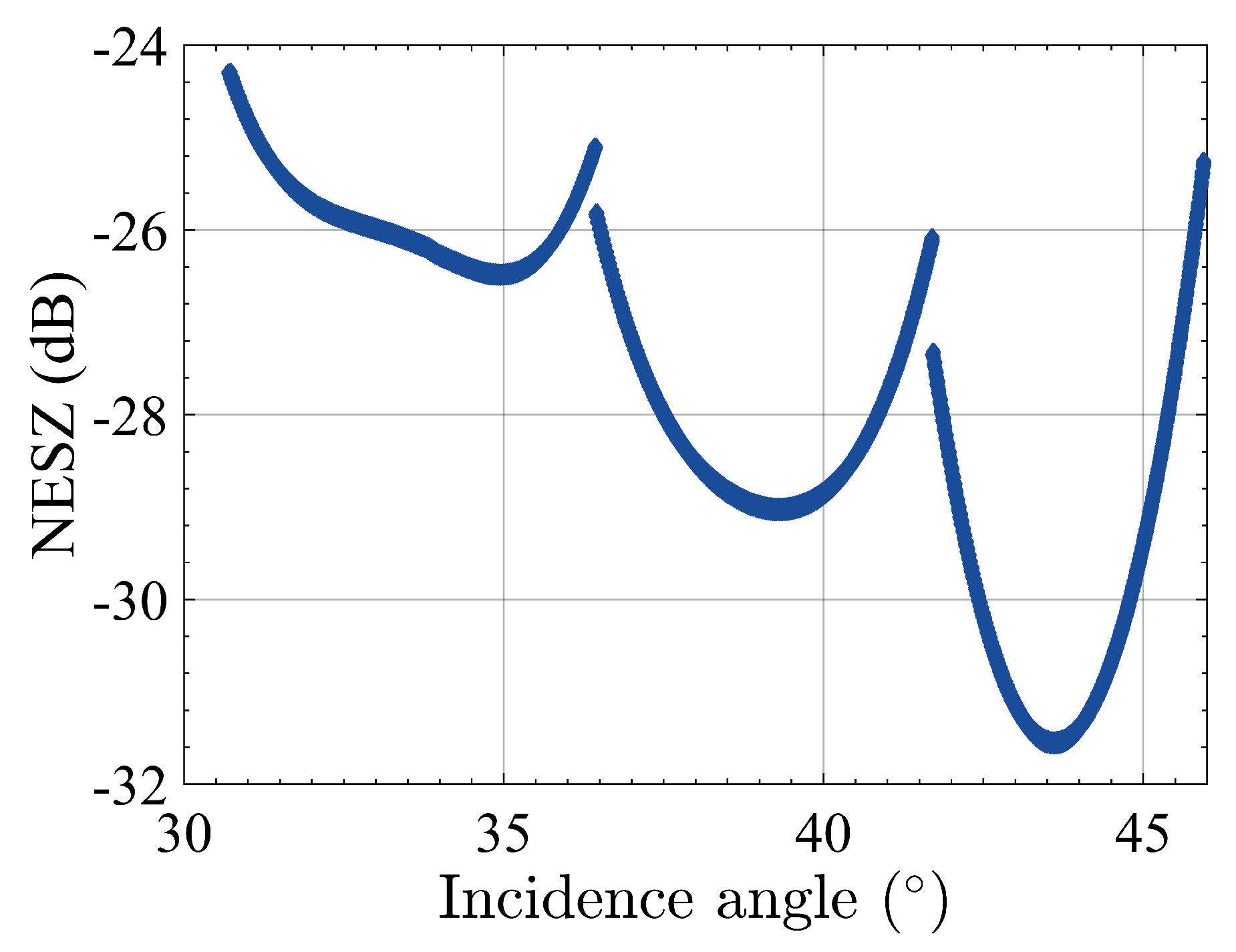
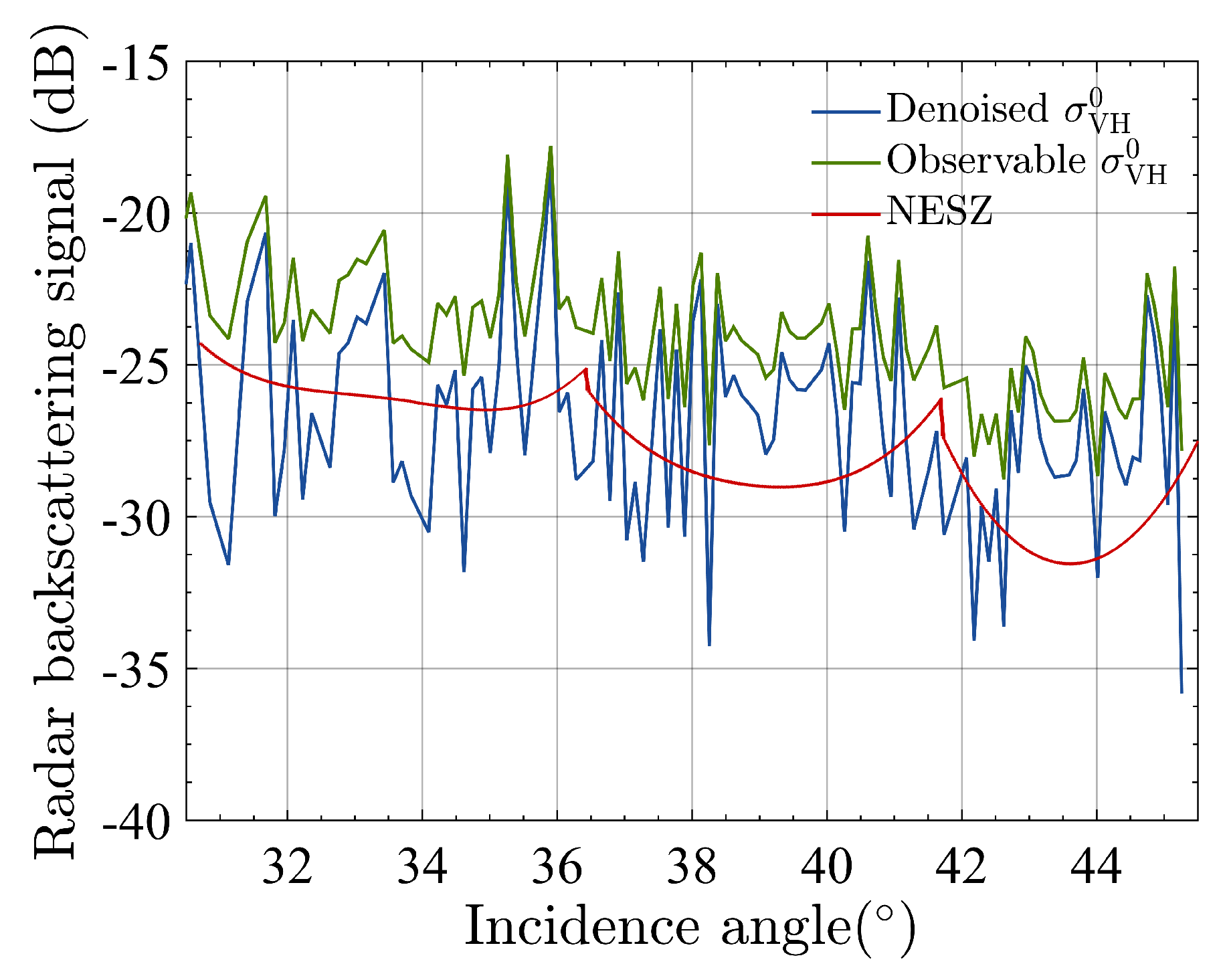

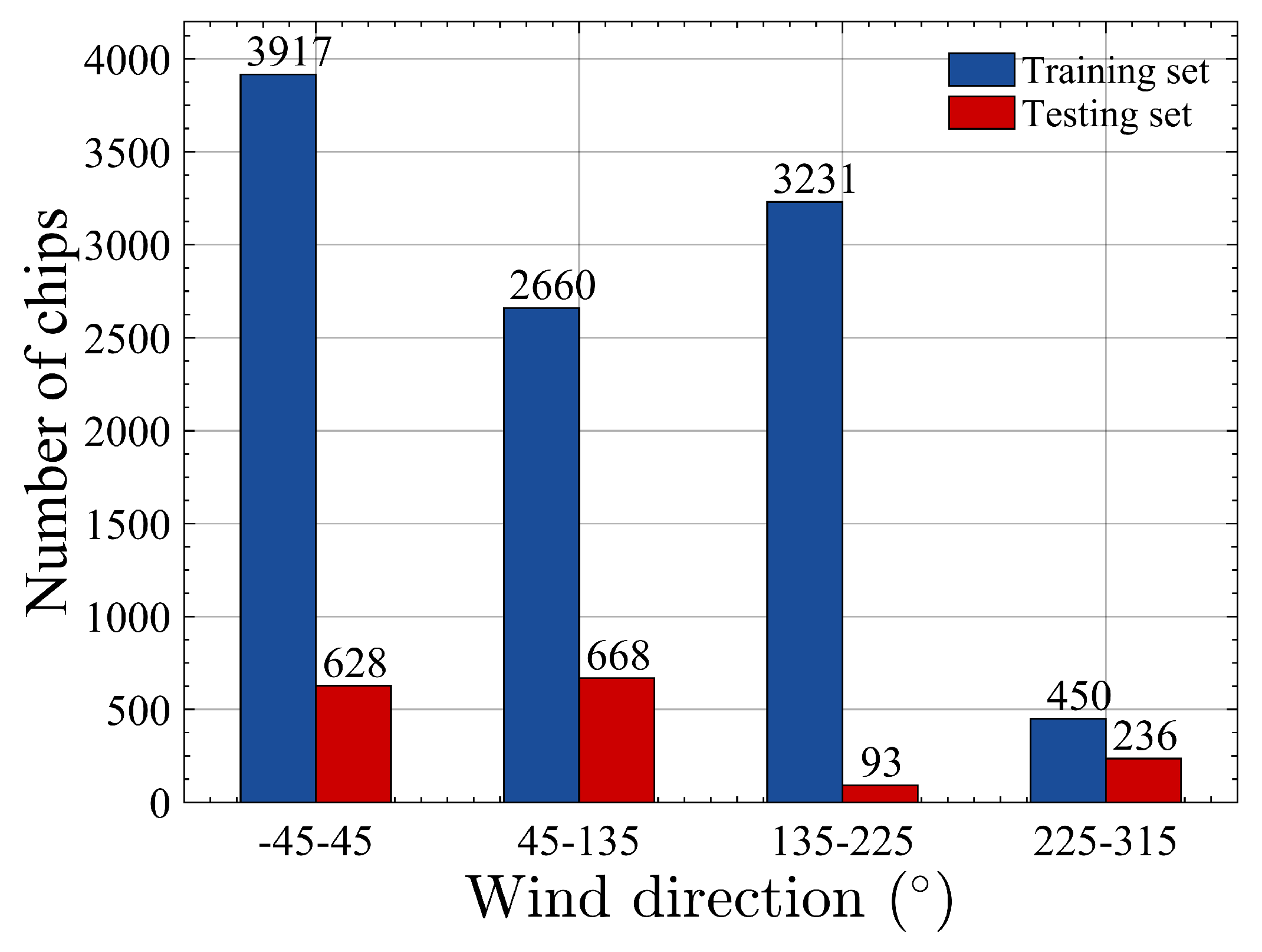
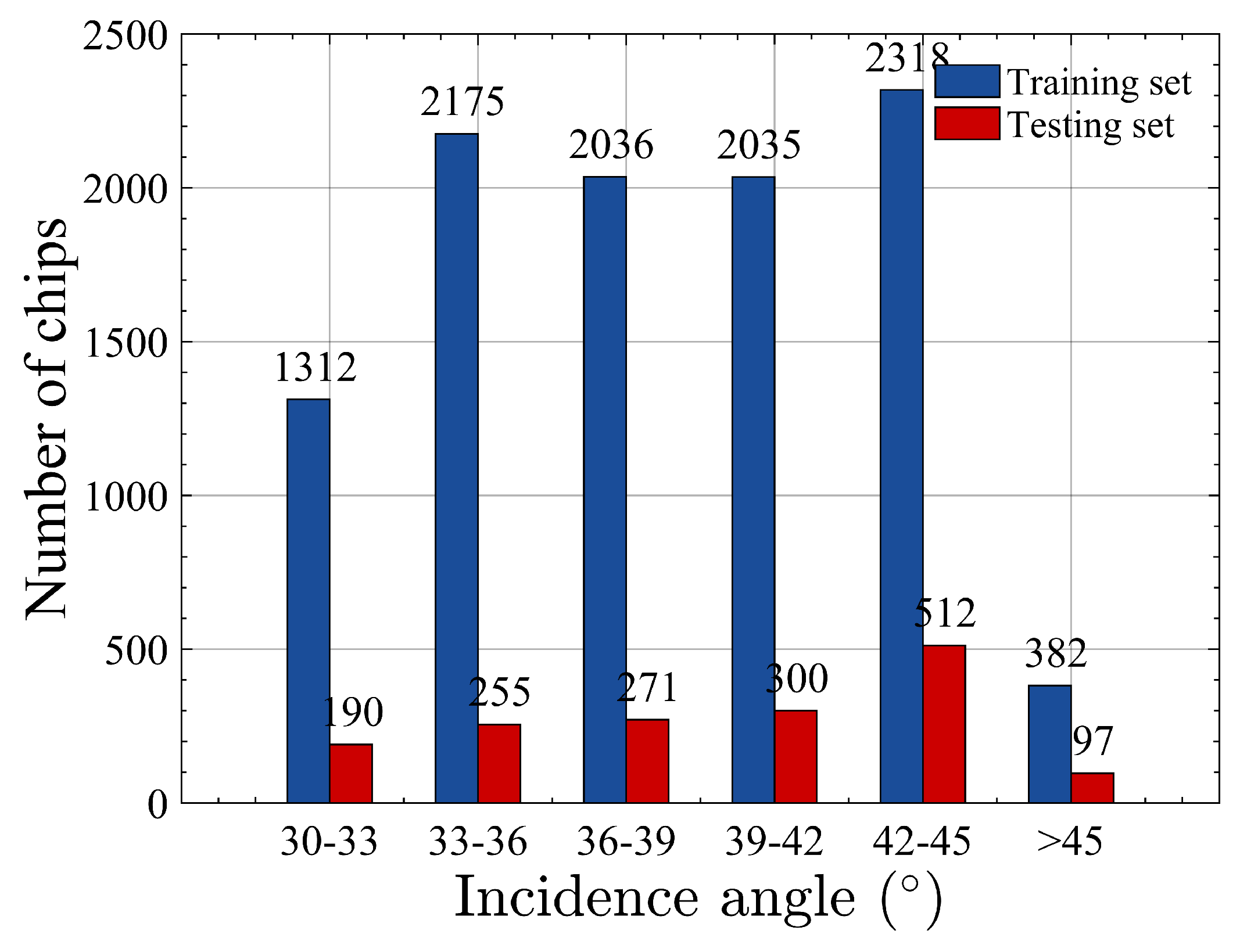
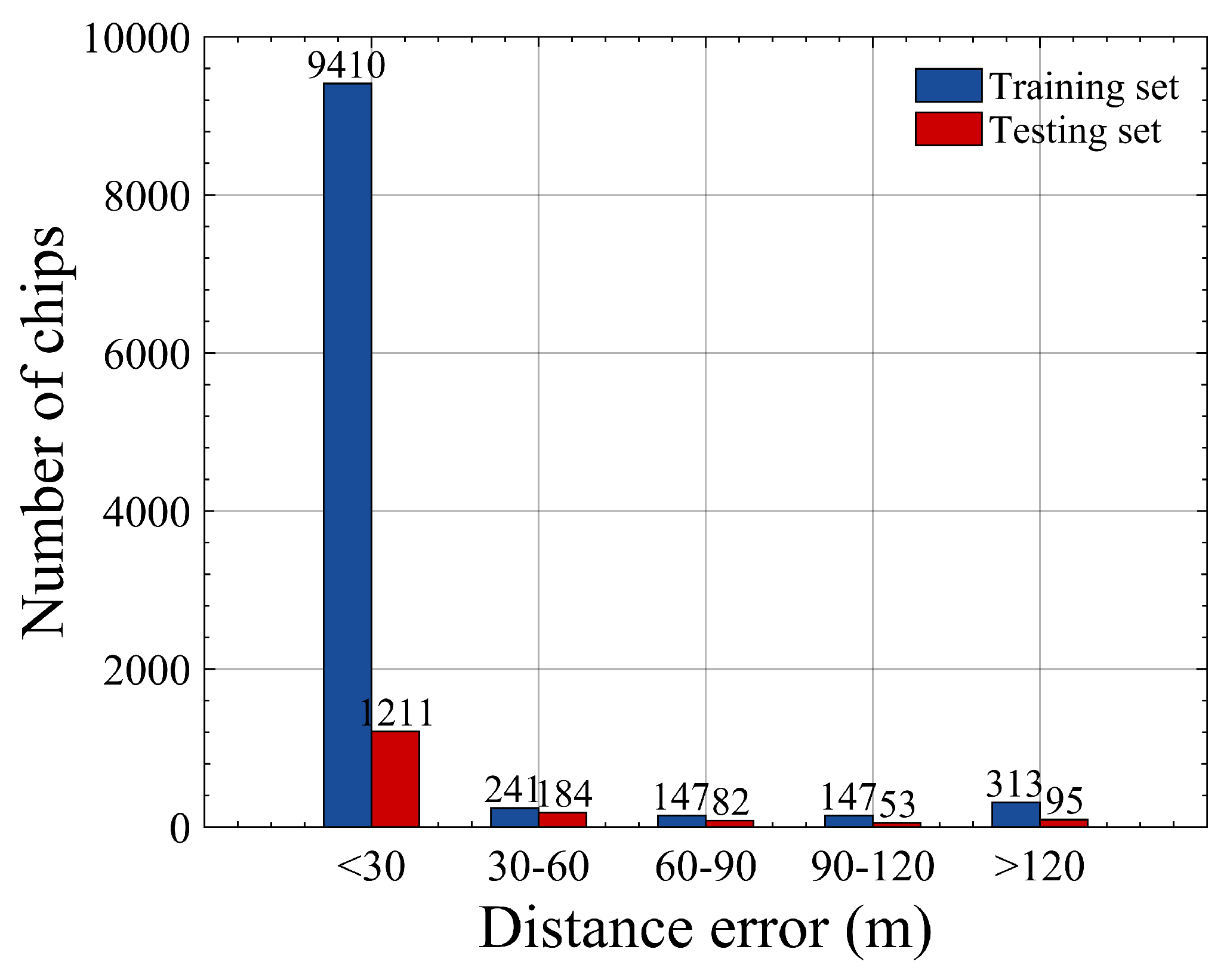



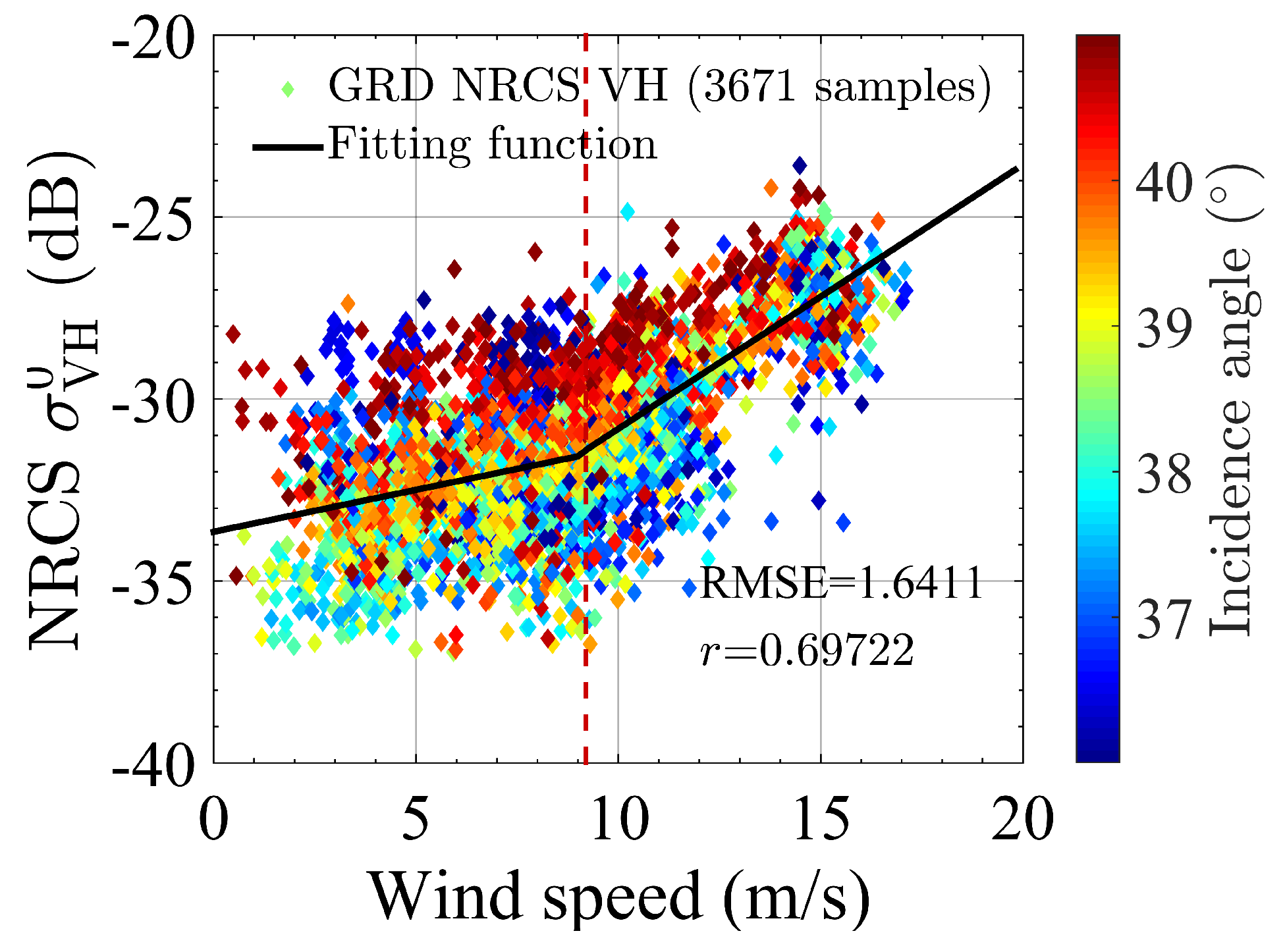



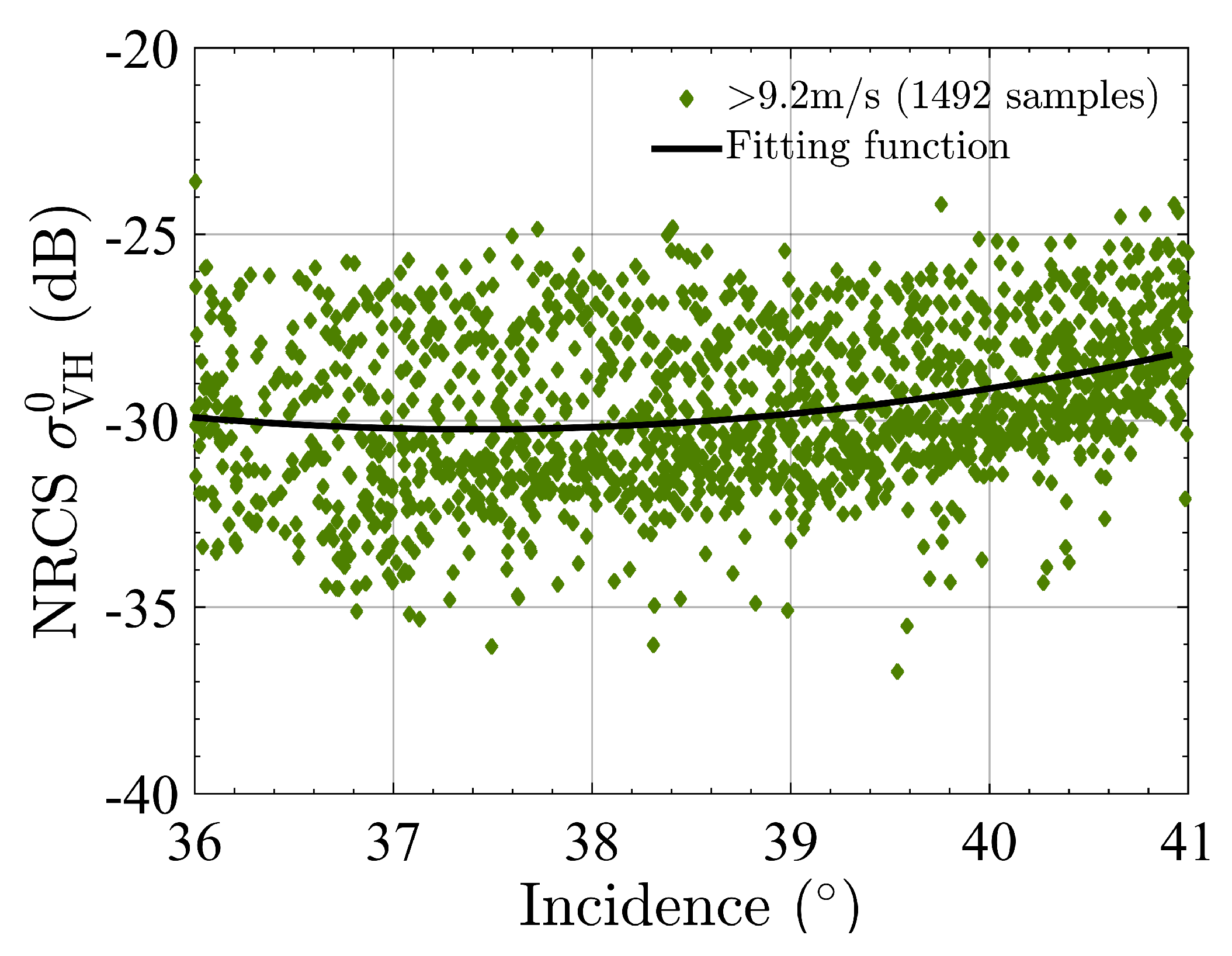

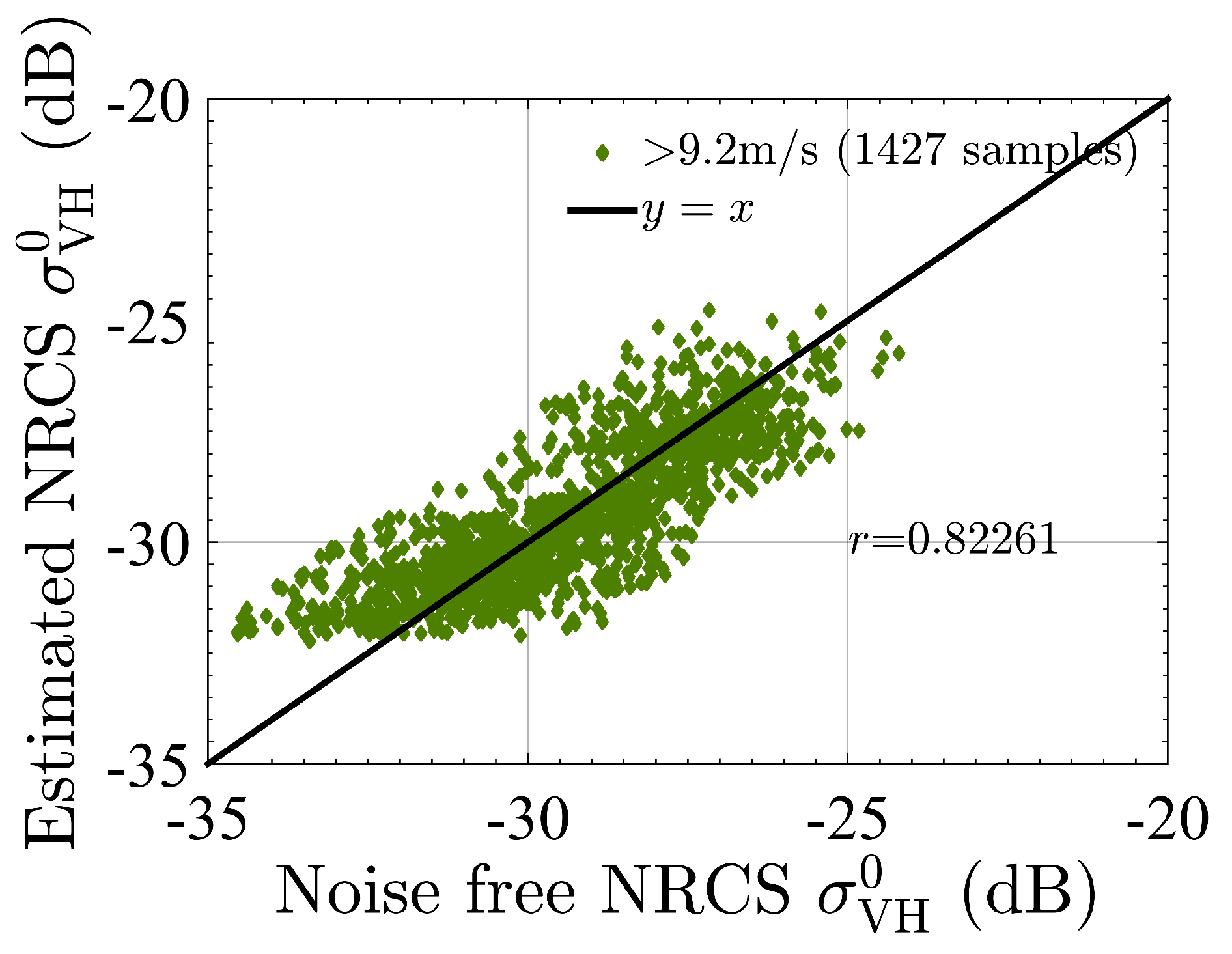
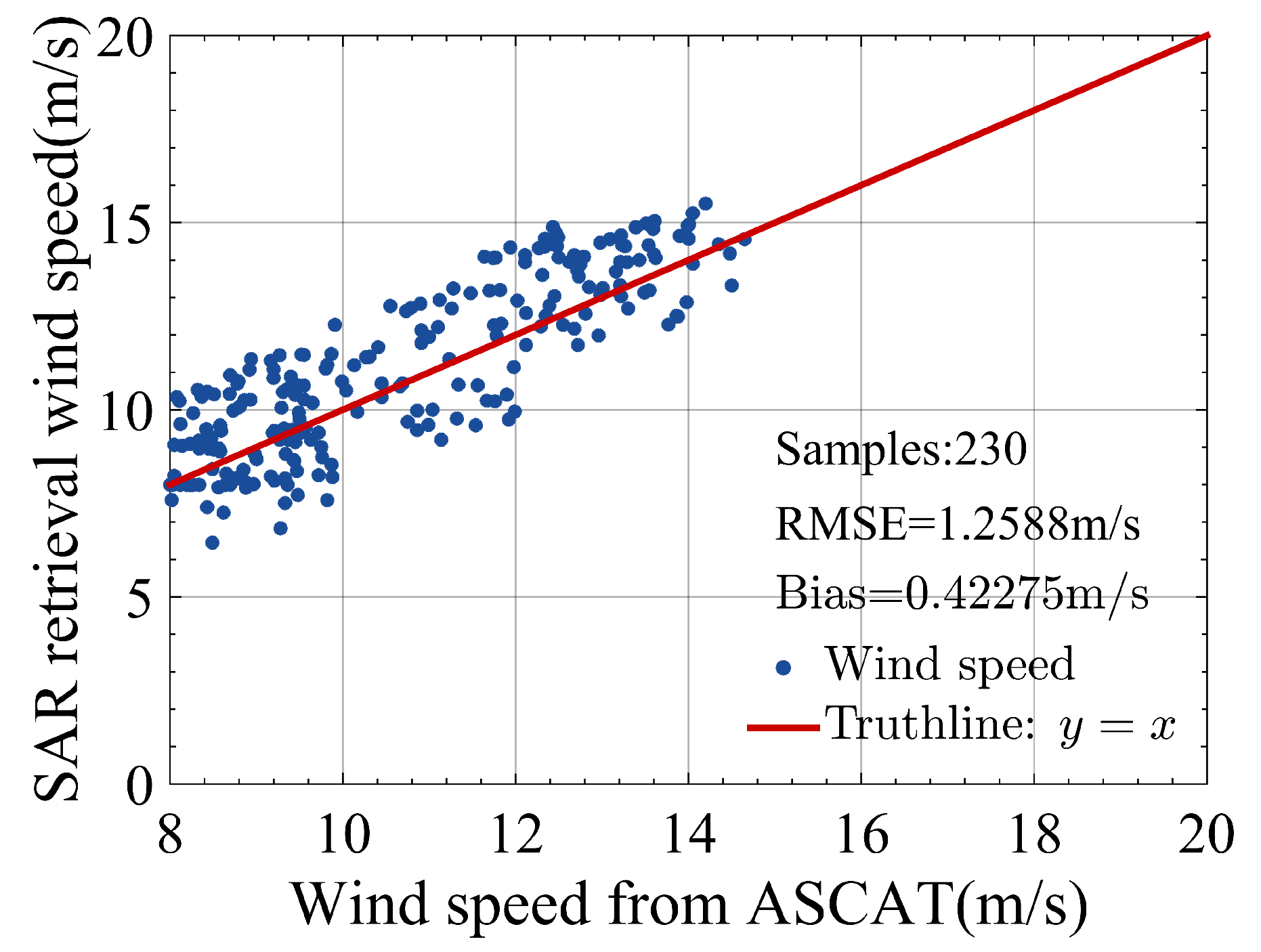
| Product Type | Resolution (rg × az) () | Pixel Spacing (rg × az) () | Swath Width (km) | Looks (rg × az) | Equivalent Number of Independent Looks |
|---|---|---|---|---|---|
| GRD | 250 | 4.9 |
| Number of Samples | RMSE | r | Fitting Function | |
|---|---|---|---|---|
| IW1-band | 3487 | |||
| IW2-band | 3671 | |||
| IW3-band | 3100 |
| Direction | [] | [] | |||||
|---|---|---|---|---|---|---|---|
| NRCS (dB) | |||||||
| Speed | |||||||
| NaN | NaN | ||||||
| Incidence Angle | Wind Speed | C | ||
|---|---|---|---|---|
| IW1-band | 30– | 8–12.3 | ||
| IW1-band | 30– | > | ||
| IW2-band | 36– | > |
| Bias | RMSE | |||
|---|---|---|---|---|
| The proposed model | ||||
| The compared model |
| Dataset | Incidence Angle | Wind Speed | Wind Speed Function | Incidence Angle Function | C | |
|---|---|---|---|---|---|---|
| 1 | 30– | 8–12.3 | ||||
| 30– | > | |||||
| 36– | > | |||||
| 2 | 30– | 8–12.3 | ||||
| 30– | > | |||||
| 36– | > | |||||
| 3 | 30– | 8–12.3 | ||||
| 30– | > | |||||
| 36– | > |
| Dataset | Bias | RMSE | ||
|---|---|---|---|---|
| 1 | ||||
| 2 | ||||
| 3 |
| Pixel Number | Incidence Angle | Wind Speed | Wind Speed Function | Incidence Angle Function | C | |
|---|---|---|---|---|---|---|
| 30– | 8–12.3 | |||||
| 30– | > | |||||
| 36– | > | |||||
| 30– | 8–12.3 | |||||
| 30– | > | |||||
| 36– | > | |||||
| 30– | 8–12.3 | |||||
| 30– | > | |||||
| 36– | > |
| Pixel Number | Bias | RMSE | ||
|---|---|---|---|---|
© 2017 by the authors. Licensee MDPI, Basel, Switzerland. This article is an open access article distributed under the terms and conditions of the Creative Commons Attribution (CC BY) license (http://creativecommons.org/licenses/by/4.0/).
Share and Cite
Huang, L.; Liu, B.; Li, X.; Zhang, Z.; Yu, W. Technical Evaluation of Sentinel-1 IW Mode Cross-Pol Radar Backscattering from the Ocean Surface in Moderate Wind Condition. Remote Sens. 2017, 9, 854. https://doi.org/10.3390/rs9080854
Huang L, Liu B, Li X, Zhang Z, Yu W. Technical Evaluation of Sentinel-1 IW Mode Cross-Pol Radar Backscattering from the Ocean Surface in Moderate Wind Condition. Remote Sensing. 2017; 9(8):854. https://doi.org/10.3390/rs9080854
Chicago/Turabian StyleHuang, Lanqing, Bin Liu, Xiaofeng Li, Zenghui Zhang, and Wenxian Yu. 2017. "Technical Evaluation of Sentinel-1 IW Mode Cross-Pol Radar Backscattering from the Ocean Surface in Moderate Wind Condition" Remote Sensing 9, no. 8: 854. https://doi.org/10.3390/rs9080854





